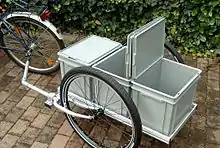Euro container
A Euro container, also called Eurobox, Euro crate or KLT box (from German: Kleinladungsträger, "small load carrier"), is an industrial stacking container conforming to the VDA 4500 standard. The standard was originally defined by the German Association of the Automotive Industry (VDA) for the automotive industry, but was subsequently adopted across many other areas of manufacturing and the shipping industry. The most common sizes (length × width) are 600 × 400 mm and 400 × 300 mm, which can be stacked together to fill a Euro-pallet measuring 1200 × 800 mm.
 R-KLT Euro 600 × 400 mm stackable container (tall version, 280 mm high) | |
| Other names |
|
|---|---|
| Classification | Inter-stacking reusable packaging |
| Types |
|
| Used with |
|
| Related | |
Dimensions
| Type | Stacking height increment (mm) |
|---|---|
| Normal | 132.5(147.5 mm overall) |
| High | 265(280 mm overall) |
Eurocontainers are based around two standard heights of 147.5 millimetres (5.8 in) and 280 millimetres (11 in), including a 15 millimetres (0.6 in) overlap in the vertical direction—the height of the feet, or base, stacked into the lip of the box below:
| Nominal | Actual | Internal[2] |
|---|---|---|
| 300×200 | 297×198 | 243×162 |
| 400×300 | 396×297 | 346×265 |
| 600×400 | 594×396 | 544×364 |
| 800×600 | 800×600 | 752×552 |
These containers are manufactured typically in grey polypropylene or another thermoplast by injection molding.


Containers with full floor and walls are watertight. Many designs have at least two or more often four rectangular (about 12 x 4 cm) rounded grip-holes near the middle of the lips. The design may include some small holes in the lowest parts of at least two walls to let liquid run out if stored outdoors in rain or after washing. Walls constructed as grids allow one to see from the side into the box. If the bottom is formed by a grid, too, air may flow easily through even stacked boxes to keep bakery dry or allow quick cooling.
Euro-containers mounted on the rear rack of a bicycle or small motorcycle are widely used by newspaper-deliverers in Austrian towns. A Euro-container fits between the frame tubes in the low transportation bay of the Danish freight bike Bullitt.
Related standards
The 400×300-millimetre sizes and stacking height were adopted in the early 1990s for inter-stacking Systainer boxes.
See also
- Cardboard box
- Banana box, a type of cardboard box designed for transportation of bananas
- EUR-pallet, the standard European pallet
- Gastronorm, a European standard for sizes on containers for kitchen use
- Manual handling of loads
- Milk crate, a similarly-sized standardized container
- Preferred metric sizes
- Reusable packaging
- Reverse logistics
- 32 mm cabinetmaking system, a standard for shelving
References
- "VDA Recommendation 4500: Small Load Carrier (KLT) System". Verband der Automobilindustrie. October 2013. Archived from the original (Zip of PDFs) on 17 March 2014. Retrieved 14 March 2014.
- "Kleinladungsträger" (PDF).
- Kleinladungsträger (KLT)-System (PDF) (Report). VDA (in German). 23 December 2005. Archived from the original (PDF) on 30 July 2018. Retrieved 30 July 2018.
Höhenraster … Einheitliche Eintauchtiefe 15 mm … 2 Höhenraster … 147,5 mm … 280 mm
– not retrievable 16 January 2019. - "Kleinladungsträger" (PDF) (in German). 29 March 2014. Retrieved 14 March 2014. – not retrievable 16 January 2019.